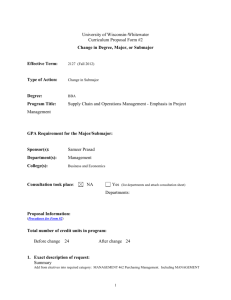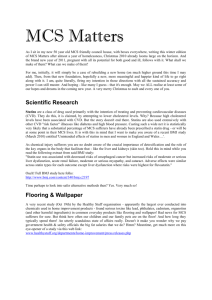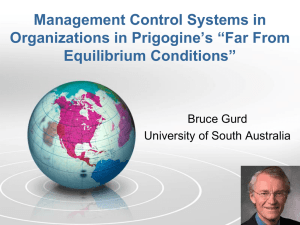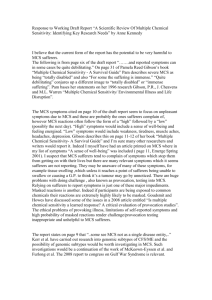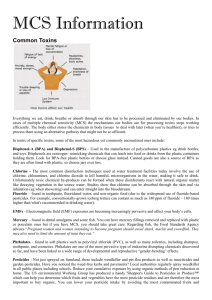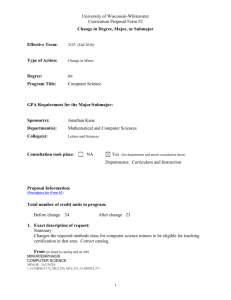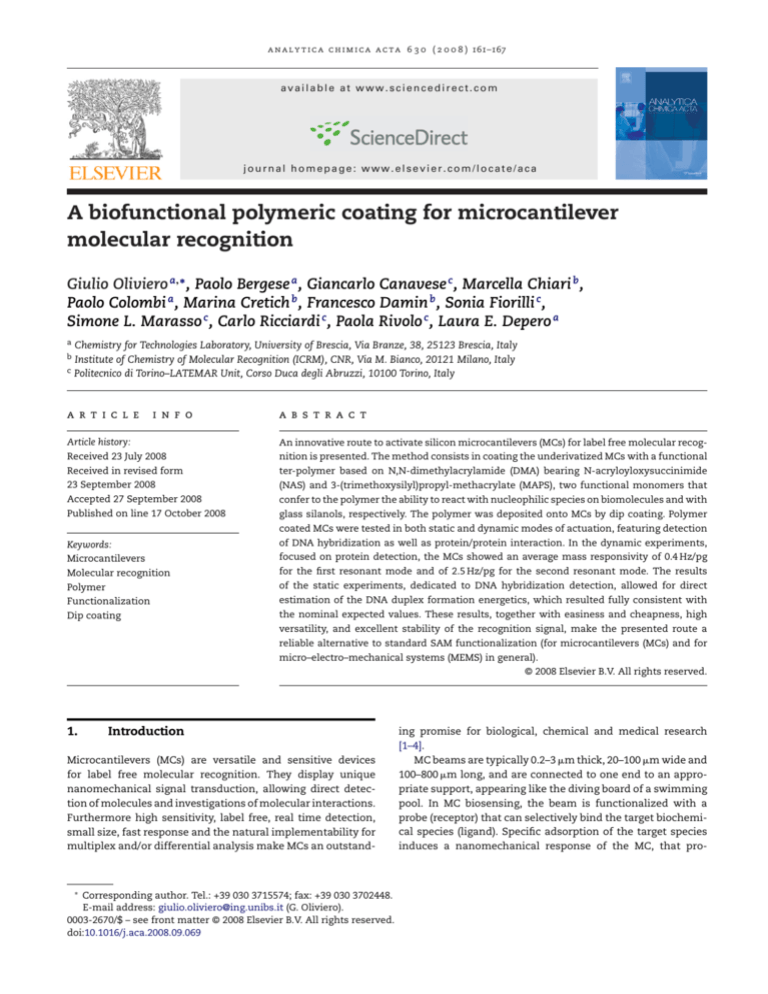
a n a l y t i c a c h i m i c a a c t a 6 3 0 ( 2 0 0 8 ) 161–167
available at www.sciencedirect.com
journal homepage: www.elsevier.com/locate/aca
A biofunctional polymeric coating for microcantilever
molecular recognition
Giulio Oliviero a,∗ , Paolo Bergese a , Giancarlo Canavese c , Marcella Chiari b ,
Paolo Colombi a , Marina Cretich b , Francesco Damin b , Sonia Fiorilli c ,
Simone L. Marasso c , Carlo Ricciardi c , Paola Rivolo c , Laura E. Depero a
a
b
c
Chemistry for Technologies Laboratory, University of Brescia, Via Branze, 38, 25123 Brescia, Italy
Institute of Chemistry of Molecular Recognition (ICRM), CNR, Via M. Bianco, 20121 Milano, Italy
Politecnico di Torino–LATEMAR Unit, Corso Duca degli Abruzzi, 10100 Torino, Italy
a r t i c l e
i n f o
a b s t r a c t
Article history:
An innovative route to activate silicon microcantilevers (MCs) for label free molecular recog-
Received 23 July 2008
nition is presented. The method consists in coating the underivatized MCs with a functional
Received in revised form
ter-polymer based on N,N-dimethylacrylamide (DMA) bearing N-acryloyloxysuccinimide
23 September 2008
(NAS) and 3-(trimethoxysilyl)propyl-methacrylate (MAPS), two functional monomers that
Accepted 27 September 2008
confer to the polymer the ability to react with nucleophilic species on biomolecules and with
Published on line 17 October 2008
glass silanols, respectively. The polymer was deposited onto MCs by dip coating. Polymer
coated MCs were tested in both static and dynamic modes of actuation, featuring detection
Keywords:
of DNA hybridization as well as protein/protein interaction. In the dynamic experiments,
Microcantilevers
focused on protein detection, the MCs showed an average mass responsivity of 0.4 Hz/pg
Molecular recognition
for the first resonant mode and of 2.5 Hz/pg for the second resonant mode. The results
Polymer
of the static experiments, dedicated to DNA hybridization detection, allowed for direct
Functionalization
estimation of the DNA duplex formation energetics, which resulted fully consistent with
Dip coating
the nominal expected values. These results, together with easiness and cheapness, high
versatility, and excellent stability of the recognition signal, make the presented route a
reliable alternative to standard SAM functionalization (for microcantilevers (MCs) and for
micro–electro–mechanical systems (MEMS) in general).
© 2008 Elsevier B.V. All rights reserved.
1.
Introduction
Microcantilevers (MCs) are versatile and sensitive devices
for label free molecular recognition. They display unique
nanomechanical signal transduction, allowing direct detection of molecules and investigations of molecular interactions.
Furthermore high sensitivity, label free, real time detection,
small size, fast response and the natural implementability for
multiplex and/or differential analysis make MCs an outstand-
∗
Corresponding author. Tel.: +39 030 3715574; fax: +39 030 3702448.
E-mail address: giulio.oliviero@ing.unibs.it (G. Oliviero).
0003-2670/$ – see front matter © 2008 Elsevier B.V. All rights reserved.
doi:10.1016/j.aca.2008.09.069
ing promise for biological, chemical and medical research
[1–4].
MC beams are typically 0.2–3 m thick, 20–100 m wide and
100–800 m long, and are connected to one end to an appropriate support, appearing like the diving board of a swimming
pool. In MC biosensing, the beam is functionalized with a
probe (receptor) that can selectively bind the target biochemical species (ligand). Specific adsorption of the target species
induces a nanomechanical response of the MC, that pro-
162
a n a l y t i c a c h i m i c a a c t a 6 3 0 ( 2 0 0 8 ) 161–167
vides the transduction/sensing mechanism. The read-out of
the response is commonly achieved by an optical lever or
a piezoresistive film integrated with the MC. The following
responses can be monitored: (1) bending of the MC induced by
the surface stress that originates by the binding of the target
species with the probes immobilized on one face of the MC
(static mode); (2) changes in the eigenfrequencies of the MC
upon the ligand mass load (dynamic mode). The first transduction mechanism is energy-based [5], while the latter is
mass-based [1].
Properly functionalized MCs have recently demonstrated
remarkable performances as biosensors. In this field, several experiments have been successfully performed, sensing
DNA hybridization (including detection of single nucleotide
polymorphisms) and detecting proteins and antibodies, single
virus particles and bacteria [1–4]. The state-of-the-art, after
the proof of concept experiments, is now moving towards
competitive sensitivity and reliability in comparison with
more mature label-based and label free biosensing methods [1–4,6]. MCs may reach sensitivities from picograms
to attograms, which are comparable with those of other
mature techniques, such as Surface Plasmon Resonance (SPR)
spectroscopy and acoustic sensors, including Quartz Crystal
Microbalances (QCM) [1]. Apart from on–off detection, (static
mode actuated) MCs can play a key role in critical molecular
recognition experiments and other fundamental biophysics
investigations. Actually, thanks to direct mechanical transduction of the energy involved in the binding reactions, they
can be employed in cases of low molecular weight (LMW)
species or in presence of conformational changes or multimeric interactions. In these cases, QCM and SPR are inherently
limited by their transduction principles [1,7]. For example,
MCs unique capabilities in experimental investigation of protein conformational changes [8–11] and cooperative work
of DNA molecular motors [12] have been already recently
proven.
Probes immobilization is of crucial importance for the efficiency and sensitivity of any surface supported biosensor.
Immobilization of the probes on the transducer without a significant change in their physicochemical nature is the first
critical step in developing surface supported bioassays. Accessibility, stability and efficiency of surface functional groups,
applicability to a wide range of relevant compounds and
robustness of the protocols are further decisive issues. In the
case of static MC biosensors, an additional request is that
the procedure ensures significant target binding-induced surface stress. According to the literature, this issue has been
faced through direct adsorption of the probes onto the MC
surface or through specific functionalization methods. The
use of thiolated molecules on gold coated MCs is the most
common functionalization method for DNA, protein and antibodies. Bacteria, viruses [13,14] and in some cases proteins
[15], have been immobilized by activation techniques based
on organosilanization. An alternative approach to gold coating
and organosilanization chemistry is to coat the underivatized
MCs with appropriate functional polymers. This approach
has found application in MC chemical sensing [16–18] and
has been adopted in biosensing by Gunter et al., who used
a poly-ethylene-oxide (PEO) coating to immobilize vaccinia
polyclonal antibodies [19].
In this work we present the results of molecular recognition tests performed on silicon MCs functionalized with
a thin layer of a functional copolymer. The polymer,
obtained by radical polymerization of three monomers, N,Ndimethylacrylamide, N-acryloyloxysuccinimide (NAS) and
3-(trimethoxysilyl)propyl-methacrylate (MAPS)], was developed for DNA and protein microarray assays on microscope
glass slides [20,21]. Then the deposition methodology, based
on simple dip coating, was implemented for silicon MCs [22].
In the cited papers we described the chemistry that allows
the polymer to bind DNA and protein receptors and calculated
the related surface coverage and efficiency of the ligand binding reaction, demonstrating that this method provides a fast,
inexpensive and robust route to bind biomolecules with high
density and efficiency. In this work we will prove the effectiveness of DMA–NAS–MAPS coating for MC molecular recognition
in both static and dynamic mode. In particular we will present
and discuss the detection of oligonucleotides hybridization in
the static mode and protein interactions in the dynamic mode.
2.
Experimental
2.1.
Materials
The
ter-polymer
(DMA-co-NAS-co-MAPS)
contains
N,Ndimethylacrylamide (DMA), N-acryloyloxysuccinimide
and 3-(trimethoxysilyl)propyl-methacrylate, respectively at
97, 2 and 1% of the total monomer mole. Hereafter the polymer
will be referred as DNM. Briefly, the polymer synthesis started
from the monomers’ dissolution in dried tetrahydrofuran
(THF). The solution was warmed to 50 ◦ C with the addition
of ␣,␣ -azoisobutyronitrile (AIBN) under a slightly positive
pressure of nitrogen for 24 h. After the polymerization,
evaporation and precipitation, the polymer was dried under
vacuum for 24 h at room temperature and stored at 4 ◦ C.
Detailed synthesis procedures and a full characterization of
DNM analytical properties can be found in Refs. [20,21].
For the static experiments, we employed arrays of eight
rectangular silicon (1 0 0) MCs (IBM, Zurich Research Laboratory, CH). The nominal dimension of each MC was 500 m in
length, 100 m in width and 1 m in thickness. Custom synthesized 5 -amine-modified and Cy3 labelled oligonucleotides
(100 nM mL−1 stock solution) from MWG (Ebersberg, Germany),
were dissolved in 200 mM sodium phosphate buffer. We
adopted two different 23-mer amino-modified probes, named,
respectively, COCU8 (5 -GCC CAC CTA TAA GGT AAA AGT GA3 ) and COCU9 (5 -TCA CTT TTA CCT TAT AGG TGG GC-3 ).
For the dynamic experiments, arrays of microcantilevers
with dimensions of 250–700 m in length, 50–80 m in width
and 2 m in thickness were fabricated using a combination
of surface and bulk micromachining process, as described in
detail elsewhere [23].
All the chemicals used for the molecular recognition experiments were from Sigma–Aldrich, Germany.
2.2.
Procedures
The MC coating was obtained through the immersion of the
MCs for 30 min in a solution of the polymer (1%, w/v in
a n a l y t i c a c h i m i c a a c t a 6 3 0 ( 2 0 0 8 ) 161–167
163
Fig. 1 – (A) Scheme of the sensor surface in the case of a static experiment. The upper drawing pictures the polymer coated
surface after DNA immobilization and blocking of the free active groups with ethanolamine. The lower picture shows a
scheme of the sensor after DNA hybridization. (B) Scheme of the sensor surface in the case of a dynamic experiment. The
upper drawing pictures the polymer coated surface after rabbit IgG immobilization and blocking of the free active groups of
the polymer with BSA. The lower picture shows a scheme of the sensor after goat IgG recognition.
a water solution of ammonium sulphate at 20% saturation
level). Finally, they were accurately washed with demineralized water and dried under vacuum at 80 ◦ C for 30 min.
Details about DNM coating on silicon MCs are reported in Ref.
[22].
2.2.1.
Procedures: static experiments
The MC arrays were cleaned in a UV-ozone cleaner (Novascan,
US) for 5 min at 30 ◦ C and then immediately coated with DNM
following the protocol described in [22].
Solutions of oligonucleotides at 5 M concentration were
printed on DNM coated MCs using a spotter by Scienion GmbH,
Germany under controlled conditions of humidity (50%) and
temperature (22 ◦ C). In each array, four MCs were printed with
COCU8, while the other four with COCU9. All MCs were covered from the basement to the tip with 16 subsequent spots of
about 400 pL. Printed arrays were then placed in an uncovered
storage box placed in a sealed chamber, saturated with NaCl,
and incubated at room temperature overnight. The residual
reactive groups of the coating were blocked by dipping the
arrays in 50 mM ethanolamine/0.1% SDS/0.1 M Tris for 30 min.
After discarding the blocking solution, the arrays were rinsed
with water and washed for 30 min in 4 × SSC/0.1% SDS buffer.
The MCs were actuated with a Cantisens Research platform
by Concentris GmbH (Basel, CH). The instrument is equipped
with a temperature-controlled measurement cell of 5 L and a
multiple laser lever system for individual MC deflection measurement.
The DNA hybridization detection was performed at 25 ◦ C in
hybridization buffer (10 mM Tris, 1 M NaCl, 0.005% Tween 20) at
a constant flow rate of 0.83 L s−1 . After the stabilization of the
MCs signals under flow for about 90 min, 250 L of the solution
of the target oligonucleotides complementary to the COCU8
probes (1 M in 2 × SSC/0.1% SDS buffer) were injected into
the chamber. The signal of the MC deflection was monitored
under constant flow at the rate of 0.83 L s−1 , but also stopping
the buffer flow after the target injection.
The hybridization signal was calculated as the difference
between the mean signal of the four MCs functionalized
with COCU8 and the mean signal of the four reference MCs
(functionalized with COCU9, 100% non complementary to the
targets). In the case of re-use of the arrays, hybridized oligonucleotides were chemically denatured by purging the cell with
30% urea salts in buffer.
Fig. 1A shows a scheme of the surface of the sensor after
the polymer functionalization (top) and the DNA probe immobilization and after the DNA detection (bottom).
In order to have a cross-check of DNA hybridization, all
the arrays were observed after the MC experiment with
a fluorescence scanner (ScanArray Lite, Perkin Elmer, MA,
USA).
2.2.2.
Procedures: dynamic experiments
The MC arrays were soaked into HF aqueous solution (0.4% v/v)
for 5 min, exposed to air plasma (RF Power = 25 W, Air Pressure = 0.4 Torr) for 10 min and polymer coated following the
protocol reported in [22].
Binding of rabbit IgG to the polymer coated MCs was
carried out by spotting 30 L of protein solution in PBS
(0.5 mg mL−1 ). MCs were then placed in an uncovered storage box placed in a sealed chamber, saturated with NaCl,
and incubated at room temperature overnight. After washes
with PBS (20 min) and water (10 min), DNM free reactive sites
were then blocked with BSA (2%, w/v) in a phosphate buffer
(50 mM, pH 7.2) for 1 h, and rinsed with PBS (20 min) and water
(10 min). MCs were then incubated for 1 h with goat IgG, dissolved in the hybridization buffer (Tris–HCl, 0.1 M, pH 8; 0.1 M
NaCl; 1% (w/v) BSA; 0.02% (w/v) Tween 20) at a concentration of 0.05 g mL−1 . After incubation, MCs were washed with
Tris–HCl (0.05 M, pH 9), 0.25 M NaCl, 0.05% Tween 20, PBS, and
water.
Fig. 1B shows a scheme of the surface of a MC after the
polymer functionalization and the rabbit IgG immobilization
(top) and after the goat IgG detection (bottom).
After each binding step, the first and second flexural modes
of the MCs were measured in vacuum (base pressure 10−5 Torr)
by means of an optical lever set-up, already described elsewhere [24].
164
a n a l y t i c a c h i m i c a a c t a 6 3 0 ( 2 0 0 8 ) 161–167
Fig. 2 – Differential signal during the under flow static
experiment for DNA detection (1 M concentration of
COCU8 complementary targets). In the inset an image of an
array after the target solution injection is shown: a clear
fluorescence signal is visible on the COCU8 immobilized
MCs.
3.
Results and discussion
3.1.
Static experiments
In order to demonstrate the effectiveness of DNM coated MCs
as static biosensors, we chose the detection of DNA hybridization as a model experiment, because the binding reaction as
well as its thermodynamic data are well known.
Arrays of eight MCs, functionalized following the polymer coating and the DNA-probe immobilization protocols
described in the previous section, were incubated in a solution of target oligonucleotides complementary to COCU8.
The difference between the mean signal of the four MCs
functionalized with COCU8 and the mean signal of the four
reference MCs (functionalized with COCU9) was monitored.
This differential deflection provides a signal of the specific
hybridization reactions purged from secondary effects such as
saline concentration gradients, fluidic and temperature drifts
and unspecific interactions between the targets and the noncomplementary probes. The measurement was performed
under flow of the hybridization buffer as well as stopping the
buffer flow after the target injection.
After the deflection measurements, the probe hybridization on COCU8 functionalized MCs was immediately crosschecked by imaging the arrays with a fluorescence scanner.
Fig. 2 shows one of the measured differential signals
obtained monitoring the MC deflections, while flowing the
target solution into the chamber. In the selected reference system, a positive deflection (z > 0) corresponds to the upward
bending of the cantilever due to tensile surface stress (with
respect to the cantilever top face), and a negative deflection
(z < 0) to a downward bending of the cantilever due to compressive surface stress. The differential deflection diverts to
a negative value after an initial positive response during the
first seconds after the target injection. This deflection trend
was measured for all the performed static experiments and
it may be generated by preliminary interactions between the
injected targets and the immobilized probes, generating a positive differential deflection corresponding to a tensile stress
upon the COCU8 functionalized MCs. After a settling down
period of the interface interactions, the hybridization of the
complementary DNA strands generates a stable compressive
surface stress on these MCs.
A fluorescence image of an array after the molecular recognition experiment is reported in the inset of Fig. 2.
Fig. 3 displays the differential signal obtained monitoring
the MC deflections, while letting the target solution to sit in
the measurement chamber overnight. The trend of the signal
demonstrates the extraordinary stability of DNM coated MCs
in aqueous buffers even during very long observation time
(14 h) in comparison with most of the experiments published
in the literature [1–4]. The fluctuations of the signal during the
first 10,000 s, enhanced by the x-scaling, may be generated by
the change of the flow conditions and by chemical and physical in-homogeneities of the buffer solution due to salt and
detergent particles precipitation and motion in the chamber.
It has to be said that during the deflection signal stabilization performed before the measurements, the DNM coated
MCs demonstrated to be subject to low thermal and fluidic
drifts and to possess excellent stability in saline buffers. In
particular, a stable signal is obtained after 90 min of buffer flow
inside the fluidic chamber with drifts of few tens of nanometers, lower values with respect to gold–thiol functionalized
MCs [1–4].
Six molecular recognition experiments were performed on
three different arrays of MCs that were regenerated for multiple measurements by removing the target in denaturing
conditions. Five experiments were performed flowing the target solution on two new and regenerated arrays, while the
remaining one consisted of an overnight experiment. The five
under flow experiments showed a mean differential downward signal of 24 nm with an error of 3 nm. The low value of the
error demonstrates not only the repeatability of the measurements but also the stability of the coating, even after multiple
re-uses of the arrays (after de-hybridization washes). The
Fig. 3 – Differential signal during the overnight static
experiment for DNA detection (1 M concentration of
COCU8 complementary targets).
a n a l y t i c a c h i m i c a a c t a 6 3 0 ( 2 0 0 8 ) 161–167
165
downward differential signal measured during the overnight
experiment resulted to be 16.5 nm.
The applied surface stress was calculated from the measured differential signal using the corrected Stoney equation
[25–28]:
=
1 zEt2
s
4 L2 (1 − )
(1)
where is the layer stress, z is the cantilever deflection, E is
the cantilever Young’s modulus, t is the cantilever thickness, L
is the cantilever length, is the cantilever Poisson’s ratio and
s is the Sader correction factor [28]. (which is expressed in
N m−1 and is also called film stress) is related to the properties
of the stress inducer, whether it is an applied film or, as in our
case, a solid–liquid reacting interface. The compressive stress
resulted to be about 5.1 mN m−1 and 3.6 mN m−1 respectively
for the under flow and the overnight experiments, values of
the same order of magnitude of the surface stress exerted by
DNA duplex formation on MCs when they are functionalized
with the “gold–thiol bond” method [1–4].
The results of the above experiments are accurately
accounted by the thermodynamic model presented in [5]. The
model describes the chemical equilibrium of a receptor/ligand
binding reaction confined at the solid–liquid interface placed
between the MC surface and the target ssDNA solution. It says
that, the standard molar Gibbs free energy of the reaction
splits into a chemical equilibrium contribution and a mechanical work contribution according to the equation:
r G◦ =
1 + RT ln cL
˛(R )initial
˛−1
,
(2)
where is the surface stress given by Eq. (1), ˛ is the
receptor/ligand binding efficiency, R is the density of the
immobilized receptor molecules and cL is the ligand concentration in the buffer solution.
The r G◦ value of the DNA hybridization reaction featured in the MC experiment was evaluated from Eq. (2)
and the experimental data compared with the nominal
value calculated from the nearest-neighbour model [29].
Taking into account the experimental physical parameters,
E = 168.5 GPa, = 0.25, T = 25 ◦ C and the binding efficiency and
the surface coverage values accurately determined in [20],
˛ = 80% and R = 3 × 1012 DNA strands, in the case of the
overnight experiment (the closest to equilibrium), one obtains
r G◦ = −113.6 ± 17 kJ mol−1 [30]. This result is consistent with
the theoretical value calculated from the nearest-neighbour
model: r G◦ = − 115.9 kJ mol−1 . The outcome of this analysis
confirms the validity of the model even when the surface
is functionalized through polymer films with complex architecture. It follows that polymer coated MCs can be used to
evaluate the standard molar Gibbs free energy, and in turn the
affinity, of the binding reaction occurring onto MCs (provided
that the binding efficiency and the receptor concentration at
the surface are known). As a side effect, this result is a further
evidence that the thermodynamic approach developed in [5]
might be a valid contribution to the open discussion about the
molecular mechanism that govern MC transduction [1,31–33].
Fig. 4 – Normalized first resonant mode of a MC (nominally
450 m × 50 m × 2 m) after each modification step during
the dynamic experiment, i.e. DNM-polymer deposition,
immobilization of rabbit IgG, passivation with BSA and
recognition of goat IgG.
3.2.
Dynamic experiments
The effectiveness of DNM coated MCs as dynamic biosensors
was assessed through a model experiment aimed at detecting
antigen/antibody interactions.
In particular, DNM coated MCs were employed to investigate the recognition reaction between the rabbit IgG (receptor)
and the goat anti-rabbit IgG (ligand). The experiments were
intended not only to quantify the molecule attachment
density, but also to assess the activity of the immobilized antibodies. In fact, the ability of the functional polymeric film
to immobilize antibodies with a native conformation of the
antigen-binding region is crucial for the effectiveness of the
sensor. DNM coated glass slides were successfully used in protein/protein interaction experiments, where we demonstrated
that both Fc and Fab domains of a capture antibody were freely
accessible once bound to the surface. The polymer coating
immobilizes probes in a random conformation and creates an
aqueous micro-environment in which epitopes have a good
accessibility [34].
The dynamic experiment consisted in monitoring the first
and second resonant curves of 10 different sized MCs before
and after each modification step (DNM coating, IgG immobilization, BSA passivation and ˛-IgG interaction) in order to
calculate the corresponding mass increments. Figs. 4 and 5
show respectively an example of the normalized peaks of
the first and second resonant modes of a MC (nominally
450 m × 50 m × 2 m) after each modification step. The
curves were fitted with a Lorentzian function and the first
and second resonant frequencies values were calculated (see
Table 1).
Since active areas of different dimensions were used, a
range of mass increments will be given, while the calculated
average surface density will be used as an index of cover-
166
a n a l y t i c a c h i m i c a a c t a 6 3 0 ( 2 0 0 8 ) 161–167
Fig. 5 – Normalized second resonant mode of a MC
(nominally 450 m × 50 m × 2 m) after each modification
step during the dynamic experiment, i.e. DNM-polymer
deposition, immobilization of rabbit IgG, passivation with
BSA and recognition of goat IgG.
age. Regarding the entire set, the relative uncertainty of such
measurements was found to be around 10%.
We monitored both the first and the second flexural modes,
because an improvement of sensitivity is expected when analyzing higher modes with respect to the fundamental one
[35–37].
The shift of the eigenfrequency value f was related to the
deposited mass variation m with the following equation [22]:
f
1 m
=−
f0
2 m0
(3)
where f0 is the resonant frequency and m0 is the mass of the
MC before molecule binding. This equation is effective when
the beam spring constant (k) remains substantially constant
after molecule binding and if the added mass is uniformly
deposited on the surfaces. This assumption is overall well
accepted in microcantilever-based biosensing, in which the
adsorbate properties such as thickness, stiffness and surface
stress, play a minor rule on the vibrational characteristics of
the Si beam [38,39]. Then we defined the mass responsivity
as R ≈ 2 fn /m and the intrinsic sensitivity of each flexural
Table 1 – The first and the second resonant frequencies
of a MC (nominally 450 m × 50 m × 2 m) after each
modification step of the dynamic mode experiment. The
data are reported with the related instrumental
uncertainty.
1st resonance
frequency (Hz)
Bare MC
DNM coating
Rabbit IgG
BSA passivation
Goat IgG
11972.6
11941.3
11940.8
11938.0
11936.3
±
±
±
±
±
0.2
0.2
0.2
0.2
0.2
2nd resonance
frequency (Hz)
74246.7
74050.0
74038.0
74028.2
74007.7
±
±
±
±
±
0.7
0.7
0.7
0.7
0.7
mode as ımn ∝ R−1 1/2 fn Qn , where fn is the n-mode resonant frequency, m is the deposited mass and Qn is the quality
factor.
The ratio between the sensitivities of the two flexural
modes (␦m1 /␦m2 ) and the average mass responsivity R were
calculated. ␦m1 /␦m2 resulted to be around 15, while R was
0.4 Hz/pg for the first resonant mode and 2.5 Hz/pg for the
second one.
Rabbit IgG immobilization induced mass increments in
the range of 9–60 pg, which in terms of molecules per surface unit leads to an average value of 5 × 1011 molecules cm−2 .
This attached protein density is slightly lower but comparable with the theoretical maximum density estimated from the
known size of an Ab IgG molecule (23.5 nm × 2.5 nm), which is
17 × 1011 molecules cm−2 [40].
The passivation of the free active sites of DNM with BSA
leaded to a mass shift in the range of 20–120 pg, which
in terms of molecules’ density corresponds to an average value of 12 × 1011 molecules cm−2 . Since planar size of
BSA (14 nm × 4 nm) [40] is very close to Ab IgG one, we
can conclude that nearly all the polymer reactive sites
were successfully saturated: 5 × 1011 molecules cm−2 of rabbit IgG plus 12 × 1011 molecules cm−2 of BSA is equal to
17 × 1011 molecules cm−2 , i.e. the theoretical maximum density for both the proteins.
The mass increments due to goat IgG interactions induced
mass increments in the range of 30–270 pg, which in terms
of molecules per surface unit leads to an average value of
15 × 1011 molecules cm−2 . The higher binding density for the
secondary antibody was expected, as secondary antibody are
able to recognize more than one site of the receptor protein.
4.
Conclusions
The effectiveness of polymer (DNM) coated silicon MCs for
label free recognition of DNA oligonucleotides and proteins
was demonstrated.
DNA hybridization experiments were performed in static
mode. Differential deflections of 23.5 nm and of 16.5 nm were
measured for the under flow and for the no-flow overnight
experiments, respectively. It turned out that in all the experiments the surface stress exerted by DNA duplex formation
was in the order of some mN m−1 , that is the same order of
magnitude of the surface stress exerted on MCs when they
are functionalized by the “gold–thiol bond” method (the most
adopted approach). We showed that DNM coated MCs have
excellent stability in saline buffers and are subject to lower
thermal and fluidic drifts in comparison with gold–thiol functionalized MCs. They can also be regenerated at least for three
times by removing the target oligonucleotides in denaturing
conditions, allowing for a fair reuse. Finally, the experimental results are consistently described by the thermodynamic
model presented in Ref. [5], demonstrating that the polymer
coated MCs (actuated in static mode) are a reliable tool for
evaluating ligand-receptor energetics.
DNM coated MCs were also employed to investigate the
recognition reaction between the rabbit IgG and the goat antirabbit IgG. In this case MCs were actuated in the dynamic
mode. The first and second flexural modes were monitored
a n a l y t i c a c h i m i c a a c t a 6 3 0 ( 2 0 0 8 ) 161–167
after DNM coating, IgG immobilization, BSA passivation and
˛-IgG interaction, in order to calculate the corresponding mass
increments. The calculated mass increments were of 9–60 pg
for the IgG immobilization, that in terms of molecules per surface unit leads to 5 × 1011 molecules cm−2 , while for the BSA
passivation we calculated a 20–120 pg mass shift, corresponding to 12 × 1011 molecules cm−2 . Finally, the goat anti-rabbit
IgG recognition induced a mass increment of 30–270 pg, corresponding to 15 × 1011 molecules cm−2 . The obtained results
are in good agreement with the literature data as well as with
theoretical calculations. The average mass responsivity was
0.4 Hz/pg for the first resonant mode and 2.5 Hz/pg for the second one. This data prove the effectiveness of DNM coated MCs
also in the dynamic mode of operation, and in particular for
detection of antigen/antibody interactions.
In conclusion, we demonstrated that the DNM polymer
provides a valid innovative and versatile MC functionalization approach, which features both static and dynamic modes
of actuation and also suits both DNA hybridization and protein/protein interactions. The ability to bind a wide range
of biomolecules with high density, the stability of the DNM
coated MCs in aqueous buffers, the re-usability of the arrays,
added to the easiness, fastness and cheapness of the coating procedure, represent a great improvement with respect to
specific and more time consuming functionalization methods
commonly adopted in the literature. Therefore DNM coated
MCs candidate themselves as an efficient analytical platform
for both DNA and protein recognition and as a reliable tool for
fundamental studies on biomolecules interactions.
Experiments devoted to the determination of the sensitivity and selectivity of DNM coated MC biosensors and to the
application of this technique to other classes of biosensors
based on Micro–Electro–Mecahnical Systems (MEMS), including Quartz Crystal Microbalances (QCMs), are underway.
Acknowledgments
The authors acknowledge the funding of the Italian Ministry of
Education, University and Research through the project PRIN
2005 “Nano-biosensors with micro-electro-mechanic technology for genomic and proteomic analysis.”
references
[1] P.S. Waggoner, H.G. Craighead, Lab. Chip 7 (2007) 1238.
[2] L.G. Carrascosa, M. Moreno, M.A. Alvarez, L.M. Lechuga,
Trends Anal. Chem. 25 (2006) 196.
[3] X. Yan, H.F. Ji, T. Thundat, Curr. Anal. Chem. 2 (2006)
297.
[4] H.P. Lang, M. Hegner, C. Gerber, Mater. Today 30 (2005).
[5] P. Bergese, G. Oliviero, I. Alessandri, L.E. Depero, J. Coll. Int.
Sci. 316 (2007) 1017.
[6] M. Li, H.X. Tang, M.L. Roukes, Nature Nanotechol. 2 (2007)
114.
[7] P. Bergese, M. Cretich, C. Oldani, G. Oliviero, G. Di Carlo, L.E.
Depero, M. Chiari, Curr. Med. Chem. 15 (2008) 1706.
167
[8] A.M. Moulin, S.G. O’Shea, R.A. Badley, P. Doyle, M.E. Welland,
Langmuir 15 (1999) 8776.
[9] R. Mukhopadhyay, V.V. Sumbayev, M. Lorentzen, J. Kjems,
P.A. Andreasen, F. Besenbacher, Nanoletters 5 (2005) 2385.
[10] T. Braun, N. Backman, M. Vogtli, A. Bietsch, A. Engel, H.P.
Lang, C. Gerber, M. Hegner, Biophys. J. 90 (2006) 2970.
[11] X. Yan, K. Hill, H. Gao, H.F. Ji, Langmuir 22 (2006) 11241.
[12] W. Shu, D. Liu, M. Watari, K. Riener, T. Strunz, M.E. Welland,
S. Balasubramanian, R.A. McKendry, J. Am. Chem. Soc. 127
(2005) 17054.
[13] J. Zhang, H.F. Ji, Anal. Sci. 20 (2004) 585.
[14] N. Nugaeva, K.Y. Gfeller, N. Backmann, H.P. Lang, M.
Duggelin, M. Hegner, Biosens. Biolectron. 21 (2006) 849.
[15] G.A. Campbell, R. Mutharasan, Biosens. Bioelectron. 21
(2005) 597.
[16] F.M. Battiston, J.P. Ramseyer, H.P. Lang, M.K. Baller, C. Gerber,
J.K. Gimzewski, E. Meyer, H.J. Güntherodt, Sens. Actuator B
77 (2001) 122.
[17] T.A. Betts, C.A. Tipple, M.J. Sepaniak, P.G. Datskos, Anal.
Chim. Acta 422 (2000) 89.
[18] G.G. Bumbu, G. Kircher, M. Wolkenhauer, R. Berger, J.S.
Gutmann, Macromol. Chem. Phys. 205 (2004) 1713.
[19] R.L. Gunter, W.G. Delinger, K. Manygoats, A. Kooser, T.L.
Porter, Sens. Actuator A: Phys. 107 (2003) 219.
[20] G. Pirri, F. Damin, M. Chiari, E. Bontempi, L.E. Depero, Anal.
Chem. 76 (2004) 1352.
[21] M. Cretich, G. Pirri, F. Damin, I. Solinas, M. Chiari, Anal.
Biochem. 332 (2004) 67.
[22] P. Bergese, E. Bontempi, M. Chiari, P. Colombi, F. Damin, L.E.
Depero, G. Oliviero, G. Pirri, M. Zucca, Appl. Surf. Sci. 253
(2007) 4226.
[23] G. Canavese, S.L. Marasso, M. Quaglio, M. Cocuzza, C.
Ricciardi, C.F. Pirri, J. Micromech. Microeng. 17 (2007) 1387.
[24] S. Bianco, M. Cocuzza, S. Ferrero, E. Giuri, G. Piacenza, C.F.
Pirri, A. Ricci, L. Scaltrito, D. Bich, A. Merialdo, P. Schina, R.
Correale, J. Vacuum Sci. Technol. B 24 (4) (2006) 1803.
[25] G.G. Stoney, Proc. Roy. Soc. London A82 (1909) 172.
[26] J.E. Sader, Appl. Phys. 89 (2001) 2911.
[27] H.J. Butt, J. Coll. Int. Sci. 180 (1996) 251.
[28] D.R. Evans, S.J. Craig, J. Phys. Chem. B 110 (2006) 5450.
[29] For calculations of molar Gibbs free energy according to
nearest-neighbour model:
http://www.basic.northwestern.edu/biotools/OligoCalc.html.
[30] For calculations of molar Gibbs free energy according to the
thermodynamical model in [5]:
http://box.ing.unibs.it/∼colombi/bend.html.
[31] M.F. Hagan, A. Majumdar, A.K. Chakraborty, J. Phys. Chem. B
106 (2002) 10163.
[32] J.C. Stachowiak, M. Yue, K. Castelino, A. Chakraborty, A.
Majumdar, Langmuir 22 (2006) 263.
[33] M. Watari, J. Galbraith, H.P. Lang, M. Sousa, M. Hegner, C.
Gerber, M.A. Horton, R.A. McKendry, J. Am. Chem. Soc. 129
(2007) 601.
[34] M. Chiari, M. Cretich, A. Corti, F. Damin, G. Pirri, R. Longhi,
Proteomics 5 (2005) 3600.
[35] S. Dohn, R. Sandberg, W. Svendsen, A. Bojsen, Appl. Phys.
Lett. 86 (2005) 233501.
[36] F. Lochon, I. Dufour, D. Rebiere, Sens. Actuator B 108 (2005)
979.
[37] G.A. Campbell, R. Mutharasan, Anal. Chem. 78 (2006) 2328.
[38] P. Lu, H.P. Lee, C. Lu, S.J. O’Shea, Phys. Rev. B 72 (2005) 085405.
[39] J. Tamayo, D. Ramos, J. Mertens, M. Calleja, Appl. Phys. Lett.
89 (2006) 224104.
[40] A.K. Gupta, P.R. Nair, D. Akin, M.R. Ladisch, S. Broyles, M.A.
Alam, R. Bashir, Proc. Natl. Acad. Sci. U.S.A. 103 (2006) 13362.


